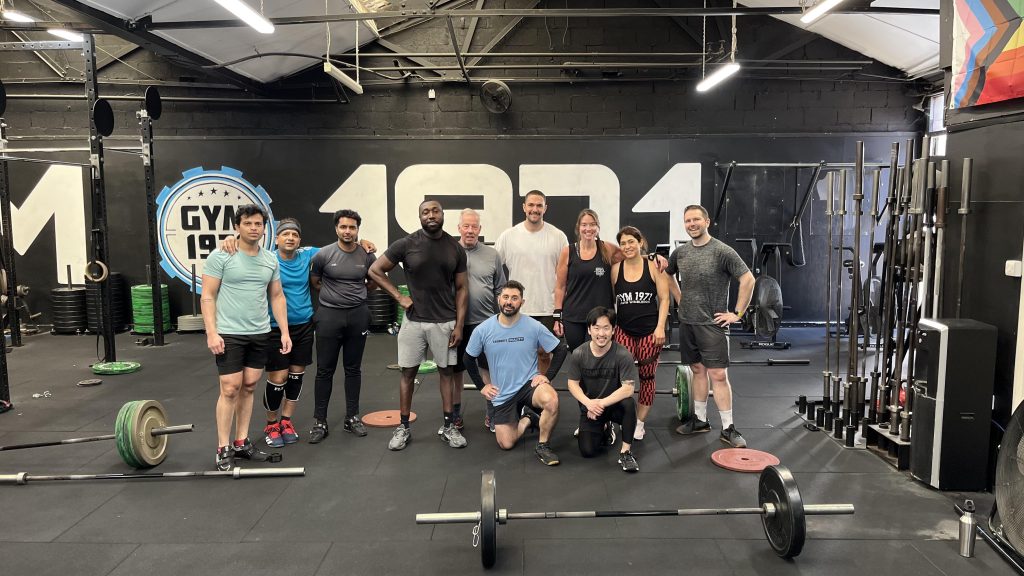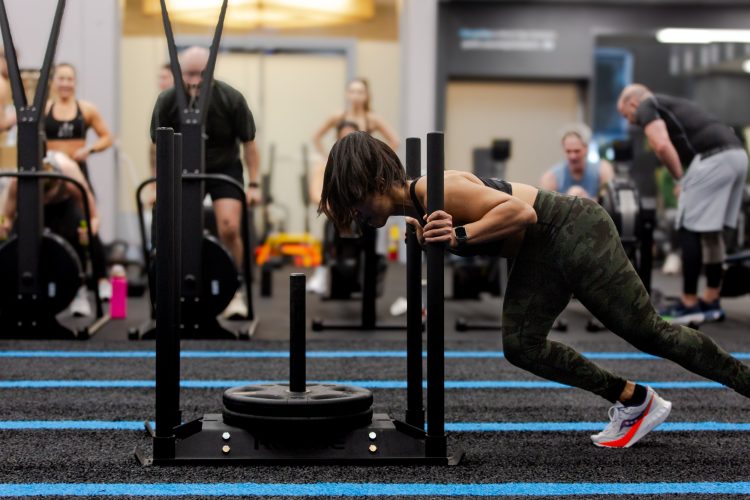Walk into any CrossFit box, and you’ll hear the sounds of barbells dropping, music pumping, and voices cheering each other on. But beneath the sweat, sore muscles, and chalk-dusted high-fives lies something far deeper than fitness. CrossFit communities, along with other group training gyms, are becoming modern tribes—a sanctuary of shared effort, vulnerability, resilience, and transformation. More than just a workout regime, CrossFit offers people an invitation to belong. In a society where loneliness has reached epidemic levels, the culture of these fitness communities is a powerful antidote: movement as a medium for human connection.
The CrossFit Philosophy: Community Over Competition
CrossFit may be known for its brutal WODs (Workouts of the Day), Olympic lifts, and intensity—but at its heart lies a community-first ethos. While each person in a class might be lifting at different weights or moving at different speeds, everyone is doing the same workout, in the same space, facing the same challenges. That commonality creates an unspoken bond. CrossFit deliberately breaks down barriers between people—there are no mirrors, no exclusive machines, no elite-only zones. Instead, the culture encourages cheering for the last person finishing a workout louder than the first. It’s a space where effort is celebrated more than aesthetics. Success is defined by showing up, not by how fast you finish. This radical redefinition of fitness culture fosters inclusion, solidarity, and belonging.
Group Training as a Social Anchor
In traditional gyms, it’s common to walk in with headphones, avoid eye contact, and complete your sets in isolation. Group training gyms like CrossFit flip this dynamic entirely. Classes begin with introductions, warm-up games, partner drills, and shared struggles. Members learn each other’s names, PRs, injuries, and even birthdays. The result is a micro-community where people feel seen and supported. Research has shown that people are more likely to adhere to exercise routines when they do it with others. But beyond consistency, group workouts deliver the kind of camaraderie that fills an emotional void in many adults’ lives. Especially for people who’ve moved to a new city, left college, or shifted careers, these gyms often become their first and most meaningful point of connection.
Stories of Social and Emotional Transformation
Talk to any long-time CrossFitter, and you’ll hear stories of physical changes—more strength, endurance, mobility—but you’ll also hear something much more profound. Members describe overcoming anxiety, battling addiction, recovering from grief, or healing from trauma. The emotional transformations often stem not just from the workouts themselves, but from the support structure surrounding them. One member may have joined after a divorce, another after losing a job. In each case, the box became more than a place to sweat—it became a space to rebuild confidence, identity, and community. One story from Brooklyn tells of a woman who struggled with postpartum depression and credits her CrossFit gym with pulling her out. “It wasn’t just the endorphins,” she says. “It was the people who showed up for me, who saw me, who reminded me that I was still strong.”
Burpees, Vulnerability, and Belonging
There’s something uniquely bonding about suffering through burpees or box jumps together. These workouts demand vulnerability—everyone struggles, everyone fails, everyone is humbled. In a world that often encourages curated perfection and isolation, CrossFit dares to be raw. That vulnerability opens the door to genuine human connection. Members don’t just see each other at their best—they witness the struggle, the missteps, the growth. And in cheering each other through tough workouts, people build trust, empathy, and a deep sense of belonging. You’re not just lifting weights—you’re lifting each other.
A Place Where Everyone Has a Name
One of the simplest yet most powerful features of CrossFit culture is the intentional effort to remember names. Coaches greet members personally, celebrate milestones like first handstand holds or deadlift PRs, and know when someone’s been absent. This personal touch transforms a transactional gym experience into a relational one. Newcomers often report feeling welcome on day one—not because they crushed a workout, but because someone remembered their name, encouraged their reps, and followed up afterward. In a time when many feel invisible, that level of recognition is transformative.
Beyond the Box: Social Networks That Extend Outside the Gym
CrossFit communities don’t stop sweating and go home—they go for coffee, share meals, plan hikes, host birthday parties, and volunteer together. These activities extend the social network beyond fitness and turn the box into a launching pad for deeper life connections. Many gyms also run events like charity WODs, holiday competitions, or local competitions that bring the wider fitness community together. These events foster pride, unity, and a sense of shared identity. More than just a gym, CrossFit boxes often become central hubs of local culture and social life.
Why It Works: Built-in Accountability and Mutual Motivation
At the heart of any successful habit is consistency—and CrossFit’s community model delivers that in spades. When people know others are expecting them, they’re more likely to show up. Accountability becomes a positive pressure: you don’t want to let your gym buddy down. Mutual motivation turns into momentum. And unlike solo workouts, where one bad mood might derail your plan, the collective energy of the class can carry you through. The same peer support that drives you to finish your reps also helps you stay committed week after week. It’s not about personal willpower anymore—it’s about group power.
Inclusivity, Not Intensity
While CrossFit’s hardcore image sometimes deters beginners, many boxes have made enormous efforts to become more inclusive. Scaled versions of workouts are not only accepted but encouraged. Coaches are trained to modify movements for injuries or new fitness levels. Some gyms even offer adaptive programs for people with physical disabilities, cancer survivors, or seniors. This commitment to accessibility broadens the appeal and impact of the community. People come to CrossFit not because they’re elite, but because they’re willing to try. And that openness creates a culture where growth is always possible—regardless of where you start.

The Role of Coaching in Fostering Connection
CrossFit coaches aren’t just instructors—they’re community leaders. They set the tone, foster safety, encourage friendships, and often act as informal therapists. A good coach can spot when someone’s off their game emotionally, adjust a workout accordingly, or offer words of encouragement that shift a member’s entire day. They create rituals, like birthday burpees or goal boards, that foster a sense of belonging. The coach’s presence turns a group of strangers into a team. Their emotional intelligence is just as vital as their technical skill, and their impact often ripples far beyond the box.
CrossFit and Mental Health: A Growing Conversation
CrossFit HQ and its affiliated gyms have increasingly leaned into conversations about mental health. Podcasts, blog posts, and social media channels now amplify stories about using fitness to manage depression, PTSD, or burnout. Some boxes collaborate with therapists, nutritionists, or mindfulness coaches to support holistic well-being. The recognition that mental and physical fitness are intertwined has helped position CrossFit not just as a workout methodology, but as a comprehensive health movement. In this context, belonging is medicine—and the box becomes a kind of healing ground.
From Lone Wolves to Lifelong Friends
In a society that often romanticizes independence, CrossFit reminds us of something ancient and true: we’re not meant to do life alone. The box becomes a modern campfire—an intentional gathering where people share effort, laughter, failure, and progress. Lifelong friendships form. Gym buddies become bridesmaids. Coaches become mentors. The shared sweat lays the groundwork for shared life. It’s this essence—not the burpees, thrusters, or pull-ups—that keeps people coming back.
Conclusion: Fitness as a Pathway to Human Connection
Ultimately, CrossFit and group training gyms offer a radical idea: fitness isn’t just about the body—it’s about the bonds we build. The gym becomes a mirror for life, showing us that we’re stronger together, more resilient in community, and more whole when we’re seen and supported. From burpees to belonging, what CrossFit teaches us transcends the physical. It’s a call to come as you are, to sweat together, and to leave better—body, mind, and spirit—because you didn’t do it alone.

















































